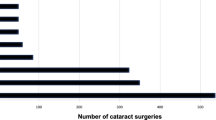Abstract
Background
‘Kissing puncta’ (KP) or punctal apposition is an anatomical phenomenon sparsely reported in the English literature. We describe our experience of managing chronic epiphora in patients with punctal apposition.
Methods
A retrospective audit of five patients (nine eyes) with KP associated with epiphora. Data including: presenting symptoms, physical signs and surgical outcomes were collected.
Results
Five patients aged between 66 and 77 years were reviewed. Common clinical features were: chronic epiphora, involutional eyelid laxity, kissing puncta (present at all phases of the blink) and reduced upper and lower margin-reflex distances. Medial upper eyelid ptosis with orbital fat prolapse was a prominent feature.
Four patients (nine eyes underwent eyelid-tightening surgery to restore normal anatomical position of the puncta. Only one of the four patients achieved improvement in epiphora at 3 months. One patient with continued epiphora underwent subsequent dacrocystorhinostomy with improvement in symptoms. The fifth patient had mild laxity and underwent dacrocystorhinostomy at first instance, with no improvement in symptoms, despite surgical success.
Conclusions
The KP sign is commonly found in those with involutional eyelid changes. Epiphora is present in variable degrees in the presence of punctal apposition. Restoration of normal punctal position with eyelid-tightening surgery does not always confer an improvement in epiphora. Surgical management in the setting of KP is therefore challenging with a guarded prognosis. Symptomatic patients with KP should be counselled accordingly.
Similar content being viewed by others
Log in or create a free account to read this content
Gain free access to this article, as well as selected content from this journal and more on nature.com
or
References
Bartley GB. Acquired lacrimal drainage obstruction: an etiologic classification system, case reports, and a review of the literature. Part 3. Ophthalmic Plat Reconstr Surg. 1993;1:11–26.
Hurwitz JJ. Examination of the eyelids. The lacrimal system. Philadelphia: Lippincott-Raven; eds. Jeffrey Jay Hurwitz, 1996. p. 48.
Glatt HJ. Epiphora caused by blepharoptosis (letter). Am J Ophthalmol. 1991;111:649–50.
Putterman A. Epiphora caused by blepharotosis. Am J Ophthalmol. 1991;111:649–50. 49
Francis IC, Wan MK. The punctal apposition syndrome: a new surgical approach. Br J Ophthalmol. 2002;86:1256–8.
Munk PL, Lin DT, Morris DC. Epiphora: treatment by means of dacryocystoplasty with balloon dilatation of the nasolacrimal drainage apparatus. Radiology. 1990;177:687–90.
Cheema MM, Meyer DR. Epiphora secondary to punctal apposition in the setting of Graves’orbitopathy. Ophthalmic Plast Reconstr Surg. 1995;11:122–4.
Tse D, Erickson B, Tse B. The BLICK mneumonic for clinical anatomical assessment of pa-tientswith epiphora. Ophthalmic Plast Reconstr Surg. 2014;30:450–8.
Author information
Authors and Affiliations
Corresponding author
Ethics declarations
Conflict of interest
The authors declare that they have no conflict of interest.
Additional information
This case series was presented at the British Oculoplastic Society Meeting, London, June 2017.
Rights and permissions
About this article
Cite this article
Joganathan, V., Patel, B.C.K., Malhotra, R. et al. The kissing puncta: an under-reported and stubborn cause of epiphora. Eye 33, 505–508 (2019). https://doi.org/10.1038/s41433-018-0273-2
Received:
Accepted:
Published:
Issue date:
DOI: https://doi.org/10.1038/s41433-018-0273-2



